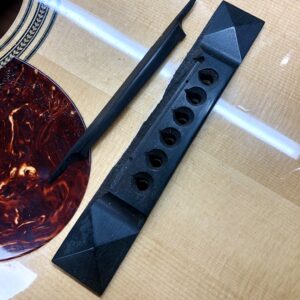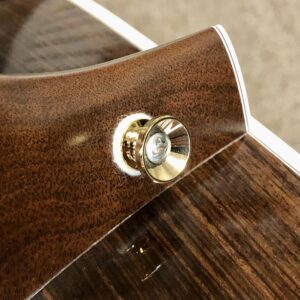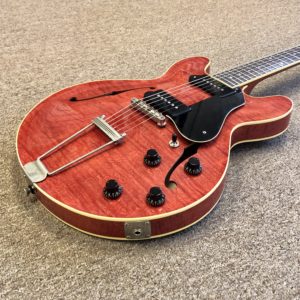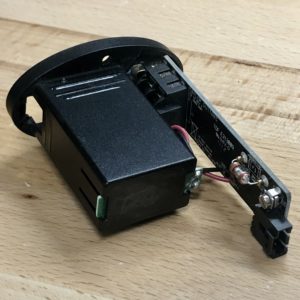Guitar Action Adjustment
Setting The String Height

Beyond the mechanics of the instrument, there is an aspect of tailoring that takes place when performing a setup. In our shop, the first step is to perform an evaluation to gather information about the instrument, as well as the client’s playing style and what they desire out of the instrument. The information gained guides us toward how to best adjust their guitar or bass in a manner that they will find comfortable.
Through countless such interactions, we have found that guitarists occasionally harbor misperceptions about the perfect setup. Nowhere is this more apparent than as regards the guitar’s “action”.
What is a Guitar's "Action?"
A guitar’s “action” refers to the height of the strings in relation to the top of the frets. The action being either “too high” or “too low” are among the more common complaints that bring clients into the guitar shop. If the action is too high, strings far away from the fretboard, the guitar can be difficult to play and may not intonate properly. If the action is too low, strings very close to the frets, the guitar may have an audible chattering or a muted buzz in certain positions as the strings vibrate against the frets.
Depending on personal taste, guitarists strive to have their playing action fall somewhere in-between those two extremes. The “sweet spot” is as varied as the instrument and its owner.
How We Measure Instrument String Action
We rely on a handful of key measurements to dial in the setup of a guitar or bass. We typically measure everything from pickup height, fretboard radius (the degree of curvature), string height at the first fret, etc. Among the measurements we rely on most heavily for measuring action are neck relief and the 12th fret string height. Comparing the findings against benchmark measurements and manufacturers specifications gives a good frame of reference for a given instrument.
The term “neck relief” refers to the degree to which the neck is bowed across its length. If the neck is “back-bowed”, negative neck relief, the notes on the first couple frets will not play cleanly because they will be hitting the frets further up the neck; This is to be avoided. Depending on playing style and preference, the goal is typically to adjust the neck somewhere between “straight” or a minimal amount of “up-bow” (also called forward-bow).
To measure neck relief, with the guitar in the playing position, we first place a straight edge across the frets. We then insert a feeler gauge between the fret tops and the bottom of the straight edge, around the 7th-9th frets, to asses how much “relief” (forward bow) there is in the neck. In conjunction with measurements taken at the nut, this gives a fair assessment of how the instrument will feel in the lower register.
To measure the 12th fret string height we use a ruler in 1/64″ graduation. While holding the guitar in the playing position, we press down the highest string at the first fret, then measure the distance between the fret top and the bottom of the string at the 12th fret. We then repeat this procedure for the lowest string. Having already determined that the strings are properly radiused to the fingerboard, and the neck is correctly adjusted, this gives us a fairly reliable measurement of the action for the instrument’s upper register.
Sample 12th Fret Action Height Measurements
for Electric and Acoustic Guitars
The following measurements assume that the guitar is generally healthy and that the neck has been properly adjusted. The first number represents the measurement of the first string at the twelfth fret; The second number is the measurement of the sixth string. These are small fractional measurements; A minor misreading can have an outsized effect on the result.
Electric Guitars
- Low Action ≈ 1/32" - 3/64" and below
- Medium Action ≈ 3/64" - 2/32"
- High Action ≈ 2/32" - 5/64" and above
Acoustic Guitars
- Low Action ≈ 3/64" - 5/64" and below
- Medium Action ≈ 2/32" - 3/32"
- High Action ≈ 5/64" - 7/64" and above
Low String Action:
There is no denying the benefits of a low action: easy bar chording and faster playing for quick runs or “sweep” picking are certainly the major ones. These are great benefits and can be crucial for some highly technical styles of playing. Low action can also be a big help to beginners, children, or people with arthritis. However, these attributes can be more advantageous for some than others. there are tradeoffs and very low action is not right for all players.
Even for a guitar that has good fretwork with level frets, very low action requires a very light picking hand in order to avoid any “fret chatter” (buzzing). For those with a light touch, or playing with so much distortion that slight rattles would be inaudible, this is not a problem. However, if you like to dig in with your picking hand, or are extremely buzz-phobic, this might be a cause for concern. Another thing to consider with low action is that your instrument will be more susceptible to seasonal shifts due to humidity fluctuations.
Medium String Action:
Players who prefer a more “medium” action have to press just a bit further to hold the strings down to the fret, but in turn they experience notes with a fuller bloom and longer sustain.
Those who love to bend strings might also benefit from a more “medium” action. Most heavy string benders say that a bit higher action helps them to “get underneath” the string as they bend, making it easier to push and pull the string to the desired pitch. Furthermore, many of you know that the fretboard of a guitar is not flat. It is radiused (curved), higher towards the center, in order to more comfortably fit our hand as we play. On an instrument with a highly radiused fingerboard, if the action is set very low to the fretboard, notes may buzz or “fret out” as they are bent. This happens because, when bending the string, you are actually forcing it into the contour of the fretboard.
High String Action
After a certain point, too much string height moves out of the realm of “preference” and can become a barrier to proper functionality. Besides making the instrument uncomfortable to play, high action can cause intonation issues. Briefly, intonation is the instruments ability to play fretted notes in tune relative to one another. If the strings are too high off the fretboard, the string must be pressed further out of its original plane in order to fret a note; Similar to the act of bending a fretted string, this raises the pitch and makes notes play “sharp” relative to the open string.
The Tao of String Action Adjustment
When clients are asked how they like their action, the response is almost universal: “as low as possible without buzzing.” This phrase is ubiquitous and, unfortunately, not of much help to a guitar tech. To put a point on it: How low an action can go without buzzing depends on a combination of factors, some of which are simply beyond a guitar techs ability to control.
There are certainly many tangible factors such as the style and quality of the instruments fretwork, preferred tuning, string gauge and composition, stringing technique, pickup height, etc. are all important. But, there is an “x” factor here that most clients overlook… The playing style and attack of the musician are the biggest variable in setting an instruments action.
The more accurately that you articulate your preferences, the better chance we have of helping get you where you want to go! A player who strums aggressively, or picks close to the fingerboard rather than nearer to the bridge, will almost certainly require higher string height to avoid buzzing compared to a player with a lighter “touch” and more precise picking control. Similarly, players who use light strings usually require a higher action than if they were willing to use a heavier gauge.
Last to consider is one’s tolerance for string noise. Some players don’t mind an occasional sizzle; One of my favorite examples is the linked recording of Tommy Emmanuel playing Classical Gas. If you start listening at about 20 seconds in, you will notice that his guitar buzzes pretty significantly when he starts upping the dynamics. It doesn’t seem to bother him, and as a listener it certainly does not prevent me from being mesmerized by his playing. Still, some other players have an uncanny ability to zero in on any offending sound and subconsciously go out of their way to pick in just such a way as to ensure that it will present itself and drive themselves nuts. Any guitar can be made to buzz if you are trying to make it buzz.

Erik Salomon - Calico Guitarworks Owner / Head Technician
Tech Talk articles are part of an ongoing effort to provide clear and detailed answers to common questions about guitar maintenance, modifications, and repairs.
While not intended as a step-by-step guide to servicing your own instrument, we hope that you will find value in the information provided.

Great Repairs Start With The Right Parts
Many of the parts mentioned in our blogs are available for purchase at:
GuitarRepairParts.com
Enter the code "TechTalk10" at checkout for 10% off your first order.
About Calico Guitarworks
Calico Guitarworks is the area’s premier destination for fretted musical instrument care and maintenance. Owned and managed by Erik Salomon, the shop is dedicated to providing quick, honest and reliable service. The staff at Calico Guitarworks has a combined 25+ years of professional guitar repair experience. Sharing the knowledge that we accumulate in this focused pursuit is at the core of what we do. Learn more About Calico Guitarworks, explore our Frequently Asked Questions, or Contact us with a specific request.






